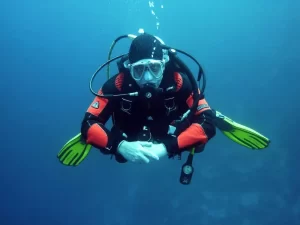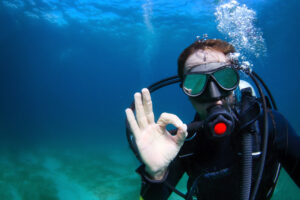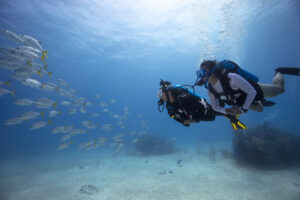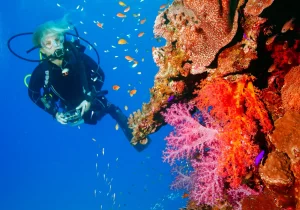Scuba diving, an exhilarating and popular recreational activity, is often perceived as challenging due to the complexities involved. This article aims to explore the question of whether scuba diving is hard by examining various aspects of the sport.
By delving into the basics of scuba diving, required skills, understanding equipment, safety precautions, and overcoming challenges, this article seeks to provide a comprehensive and informed perspective on the difficulty level associated with scuba diving.
Additionally, it will discuss different diving environments, buoyancy control mastery, advanced techniques, and tips for successful experiences.
Overall, through a thorough analysis of these topics, readers will gain a better understanding of the challenges and skills required for scuba diving.
Key Takeaways Is Scuba Diving Hard
- Scuba diving requires a thorough understanding of equipment and safety procedures.
- Mastery of buoyancy control and underwater navigation is essential for successful diving.
- Acquiring scuba diving certifications is necessary to ensure proper training and knowledge.
- Following safety protocols and regularly maintaining equipment are crucial for minimizing risks in diving.
The Basics of Scuba Diving
The basics of scuba diving encompass understanding the equipment, safety procedures, and fundamental techniques involved in underwater exploration.

Scuba divers must possess a comprehensive knowledge of their gear, including the mask, fins, regulator, and buoyancy control device. They must also learn the proper methods for assembling and disassembling their equipment to ensure its functionality and reliability during dives.
Safety procedures are crucial to prevent accidents and minimize risks while exploring the depths. These include pre-dive checks, buddy systems, emergency ascent protocols, and decompression stops.
Additionally, divers should be familiar with fundamental techniques such as equalizing pressure in their ears and sinuses, controlling buoyancy through breathing patterns, and navigating underwater using compasses or natural landmarks.
Furthermore, being aware of underwater wildlife behavior is essential to protect oneself and preserve marine ecosystems.
Obtaining diving certifications from recognized organizations ensures that divers have received proper training to engage safely in this exhilarating activity.
Required Skills for Scuba Diving
The mastery of essential scuba diving skills is crucial for a safe and enjoyable underwater experience. These skills include proper buoyancy control, effective communication techniques, and proficiency in equipment handling.

Additionally, mastering underwater techniques such as equalization, navigation, and underwater photography enhances the diver’s overall competence and confidence in exploring the depths.
Essential Scuba Diving Skills
Acquiring essential scuba diving skills is crucial for individuals interested in engaging in this activity. These skills are typically obtained through a scuba diving certification program, which provides comprehensive training on the necessary techniques and safety measures involved in scuba diving. The certification process ensures that divers have the knowledge and ability to handle potential challenges and risks underwater.

In these programs, aspiring divers learn how to properly use scuba equipment, control buoyancy, navigate underwater, communicate with hand signals, and manage emergency situations. Additionally, understanding the specific characteristics of different scuba diving locations is essential for a successful dive. Factors such as water temperature, visibility, currents, marine life presence, and depth should be considered when planning a dive.
Developing these essential skills and knowledge allows divers to safely explore the wonders of underwater environments.
Mastering Underwater Techniques
Mastering underwater techniques involves developing precise control over buoyancy, refining navigation skills, and effectively communicating with hand signals. These skills are essential for scuba divers who want to explore the underwater world and engage in activities such as underwater photography and marine life observation.

To evoke an emotional response in the audience, here are four reasons why mastering these techniques can be both exhilarating and rewarding:
- Immersion in a vibrant ecosystem: By honing their underwater techniques, divers gain access to breathtaking scenes of coral reefs, colorful fish, and other fascinating marine creatures.
- Capturing unique moments: Underwater photography allows divers to document the beauty of the aquatic environment and share it with others, creating lasting memories.
- Deepening understanding of marine life: Mastering underwater techniques enables divers to observe marine species up close, learn about their behavior patterns, and contribute to conservation efforts.
- Overcoming challenges: Developing these skills requires dedication and practice. Successfully mastering them can provide a sense of accomplishment and open doors to new opportunities for exploration beneath the surface of the water.
Safety Measures in Diving
Implementing proper safety measures is crucial in diving to mitigate potential risks and ensure the well-being of divers. Diving accidents can occur due to various factors, such as equipment failure, lack of training, or disregard for safety protocols. To minimize these risks, divers must follow established emergency procedures. This includes having a clear understanding of how to respond to different situations underwater, such as buddy separation or loss of visibility.
Divers should also be knowledgeable about decompression sickness and understand the importance of adhering to dive tables and computer-generated dive profiles. Additionally, regular equipment maintenance and inspections are essential in preventing malfunctions that could lead to accidents.
By prioritizing safety measures and being prepared for emergencies, divers can enjoy their underwater adventures while minimizing risks associated with diving accidents.
Transition: Understanding the equipment used in scuba diving is another crucial aspect that contributes to safe diving practices.
Understanding the Equipment
Familiarity with scuba diving equipment is essential for divers to ensure their safety and successfully navigate underwater environments. Understanding scuba diving equipment and the importance of proper gear maintenance can greatly enhance the overall diving experience. Here are four key points to consider:
- Safety: Properly maintained equipment reduces the risk of malfunctions or accidents, ensuring a safe dive.
- Performance: Well-maintained gear performs optimally, allowing divers to fully enjoy their underwater exploration.
- Comfort: Familiarity with equipment leads to improved comfort levels, enabling divers to focus on their surroundings rather than discomfort.
- Reliability: Regular inspection and maintenance of gear instills confidence in its reliability, giving divers peace of mind during dives.
Safety Precautions for Scuba Diving
Scuba diving is an exhilarating recreational activity that requires careful attention to safety precautions.
Two key aspects of scuba diving safety are the use of essential safety gear and the implementation of the dive buddy system.
Essential safety gear includes items such as a buoyancy control device, regulator, dive computer, and a mask and snorkel.
The dive buddy system involves pairing divers together to ensure mutual support and assistance throughout the dive, thereby enhancing overall safety.
Essential Safety Gear
Essential safety gear, such as a dive mask, regulator, and buoyancy control device (BCD), is crucial for scuba diving to ensure the diver’s safety and comfort underwater.
Proper communication techniques are essential when diving to avoid misunderstandings or potential dangers. Underwater hand signals, for example, allow divers to communicate without relying on verbal communication.
Choosing the right dive location is also important in ensuring a safe and enjoyable experience. Factors such as visibility, water temperature, currents, and marine life should be considered when selecting a dive site.
It is recommended that divers research potential locations beforehand and consult with experienced local divers or dive centers who can provide valuable insights into the conditions of different sites.
Investing in high-quality equipment and being knowledgeable about underwater communication techniques and choosing the right dive location contribute significantly to a safer and more fulfilling scuba diving experience.
Dive Buddy System
The dive buddy system is a widely recognized practice in recreational diving where two or more divers are paired together to ensure mutual safety and assistance underwater. Each dive buddy has specific responsibilities that contribute to the overall safety of the dive. These responsibilities include maintaining visual contact with their partner, checking each other’s equipment before entering the water, monitoring each other’s air supply, and being prepared to assist in case of an emergency.
Effective communication techniques are crucial in the dive buddy system. Divers use hand signals, such as indicating they are okay or signaling for help, to communicate underwater where verbal communication is not possible. Clear and concise communication between buddies is essential for coordinating movements, sharing information about potential hazards, and ensuring a smooth and safe dive experience.
Overcoming Common Challenges
One of the common challenges faced by individuals when learning to scuba dive is overcoming potential difficulties. Scuba diving can be a daunting activity for many due to various factors such as fears and concerns about dealing with underwater pressure. Here are four common challenges that divers may encounter:
- Claustrophobia: The confined space of scuba gear and being submerged in water can trigger feelings of claustrophobia, requiring individuals to manage their anxiety levels.
- Equalizing ear pressure: The change in water pressure can cause discomfort or pain in the ears, necessitating proper techniques like equalization to relieve the pressure.
- Fear of marine life encounters: Some divers may have apprehension about encountering unfamiliar marine creatures, necessitating education and familiarization with different species.
- Buoyancy control: Achieving neutral buoyancy is crucial for an enjoyable dive experience; however, mastering this skill can be challenging and requires practice.
Overcoming these challenges through proper training, guidance, and gradual exposure helps individuals become confident and competent divers.
Transitioning into the subsequent section on ‘diving in different environments,’ understanding how to overcome these initial obstacles sets a strong foundation for exploring various underwater habitats.
Diving in Different Environments
Diving in different environments presents unique challenges and requires specific skills. One such environment is cave diving, which involves exploring underwater caves. Cave diving demands specialized training due to the restricted spaces, potential for disorientation, and limited visibility caused by silt or sediment. It is crucial for divers to possess excellent navigation skills and maintain constant contact with a guideline to ensure safe exploration of these intricate systems.
Another exciting type of diving is interacting with marine life. Whether it’s swimming alongside colorful schools of fish, encountering majestic sea turtles, or observing fascinating coral reefs, diving with marine life offers a captivating experience. However, divers must exercise caution and adhere to responsible practices to minimize disturbance to the natural habitat and avoid any harm to themselves or the marine creatures they encounter.
Transitioning into the subsequent section about mastering buoyancy control…
Mastering Buoyancy Control
Achieving mastery in buoyancy control is essential for divers as it enables them to maintain their position in the water column and navigate through different depths with precision. Proper buoyancy control allows divers to conserve energy, reduce air consumption, and minimize the risk of damaging delicate ecosystems.
Here are four key techniques and tips for maintaining proper buoyancy:
- Breathe steadily: Slow, controlled breathing helps maintain a consistent depth by preventing sudden changes in lung volume.
- Use your lungs as a buoyancy device: By inhaling deeply, divers can increase their buoyancy and rise towards the surface; exhaling slowly decreases buoyancy and allows for descent.
- Fine-tune your weighting: Adjusting weights allows for neutral or slightly negative buoyancy, which aids in controlling descent rates.
- Practice trim and body positioning: Maintaining a horizontal posture with streamlined equipment minimizes drag and facilitates efficient movement through the water.
With patience, practice, and attention to detail, mastering these techniques will enhance diver safety while maximizing enjoyment of underwater exploration.
Advanced Techniques in Scuba Diving
To further enhance their skills, divers can engage in advanced techniques that require a deep understanding of buoyancy control and precise body movements. These advanced buoyancy techniques allow divers to navigate through various underwater environments with ease and efficiency.
One such technique is the use of trim weights to achieve perfect balance in the water, enabling divers to maintain a horizontal position without excessive effort.
Additionally, deep diving strategies involve proper gas management and decompression procedures to safely explore depths beyond recreational limits. Advanced divers also employ specialized equipment such as dive computers and redundant gas supplies for added safety during deep dives.
By mastering these advanced techniques, divers can expand their underwater capabilities and have more rewarding diving experiences.
Transitioning into the subsequent section about ‘tips for successful diving experiences’, it is important for divers to remember that while advanced techniques are valuable, they should always prioritize safety and adhere to recommended guidelines.
Tips for Successful Diving Experiences
One essential consideration for successful diving experiences is the proper selection and maintenance of equipment. To ensure a safe and enjoyable dive, beginners should keep in mind several tips and avoid common mistakes.
1) Proper training: Beginners should undergo thorough scuba diving training to acquire the necessary skills and knowledge.
2) Equipment fitting: It is crucial to have well-fitted equipment that ensures comfort and ease of movement underwater.
3) Buddy system: Diving with a buddy enhances safety by providing mutual support and assistance in case of emergencies.
4) Dive planning: Adequate dive planning includes checking weather conditions, depth limits, and dive sites to ensure a smooth experience.
By following these tips, beginners can avoid common mistakes such as neglecting proper training, using ill-fitting gear, diving alone without supervision, or failing to plan dives effectively.
These measures will contribute to safer and more enjoyable experiences for divers.
Frequently Asked Questions
What Are Some Common Health Risks Associated With Scuba Diving?
Common health risks associated with scuba diving include decompression sickness, barotrauma, nitrogen narcosis, and oxygen toxicity. Safety precautions such as proper training, equipment maintenance, and adhering to dive limits can mitigate these risks.
How Long Does It Typically Take to Become a Certified Scuba Diver?
The typical duration for scuba diving certification varies depending on the program and individual progress. The scuba diving certification process involves completing classroom sessions, pool training, and open water dives to meet the requirements set by certifying agencies.
What Is the Maximum Depth That a Beginner Scuba Diver Can Safely Reach?
The maximum depth that a beginner scuba diver can safely reach depends on their training and experience. Generally, it is recommended for beginners to stay within the range of 18-30 meters (60-100 feet) to ensure safety and minimize risks associated with diving.
Are There Any Age Restrictions for Scuba Diving?
Age restrictions for scuba diving vary across different countries and diving organizations. Safety measures such as medical questionnaires, physical fitness requirements, and supervised training are typically implemented to ensure the well-being of divers.
Can I Scuba Dive if I Have a Fear of Water or Swimming?
Scuba diving requires proficiency in swimming and comfort in water. Overcoming a fear of water or swimming is crucial for individuals who wish to engage in scuba diving, as it involves being submerged underwater for extended periods.
Conclusion
Scuba diving is a challenging but rewarding activity that requires the mastery of various skills and techniques. From understanding the basics of scuba diving to overcoming common challenges, divers must develop a strong foundation of knowledge and experience.
By mastering buoyancy control and advanced techniques, divers can navigate different environments with ease. However, safety precautions should always be followed to ensure a successful diving experience.
Scuba diving can be likened to exploring an underwater world filled with hidden treasures, where each dive offers a unique adventure waiting to be discovered.




